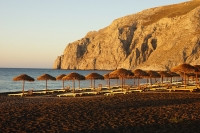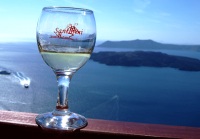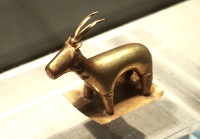Things to do in Santorini
Santorini has some great attractions, including volcanoes, beaches and museums. Visitors will find the volcanic islands of Nea Kameni (Young Burnt Island) and Palea Kameni (Old Burnt Island) in the Santorini caldera. They're the youngest volcanic lands in the Eastern Mediterranean, with Nea Kameni having formed less than 500 years ago. Perissa and Perivolos are two of Santorini's most popular beaches, and travellers can choose from a selection of tavernas and restaurants on their black-sanded shores. Agios Georgios also has some amenities and tavernas, but the southern tip of the island tends to be quieter.
The Museum of Prehistoric Thera is worth a visit, with its wall-paintings, golden ibex figurine and Neolithic pottery exhibits. Santorini's wineries are appealing, as are the island's smaller villages, where visitors can enjoy a more traditional atmosphere. Megalochori, Pyrgos, and nearby Thirasia Island are all options. Santorini Water Park is a great stop for kids.

Santorini Beaches
The beaches of Santorini are unlike other Greek beaches and have special and dramatic geological features such as black shining pebbles and unique land formations, coloured by blac…
Santorini Beaches
The beaches of Santorini are unlike other Greek beaches and have special and dramatic geological features such as black shining pebbles and unique land formations, coloured by black, white and red sands. They tend to be coves surrounded by steep cliffs that add to their beauty. The waters are deep, though, so visitors should be cautious.
The Red beach is possibly the most famous and is located near the village and ancient site of Akrotiri. It's popular because of the stunning volcanic slabs and colour of its sand, though the sand isn't comfortable to sit on so the sun loungers on the beach are necessary. Perissa beach, just southeast of Fira, is another favourite and has an impressively long, black sandy shore with an enormous rock rising out of the sea.
For those who prefer a quiet and unspoilt beach environment, Cape Columbo is one of Santorini's most beautiful and most isolated beaches. The waves here are rougher, though, so visitors should beware of a more dangerous sea. The southeastern beaches of Monolithos, Avis and Kamari are family favourites. At Monolithos beach kids love the football pitch, basketball court and play area; trees at the back of the beach provide shaded respite from the sun.

Santorini Wineries
Santorini is a large wine-producing region, which was helped along by a volcanic explosion in 1650 BC. The vines on the island are very old, and are drained into a distinctive bask
Santorini Wineries
Santorini is a large wine-producing region, which was helped along by a volcanic explosion in 1650 BC. The vines on the island are very old, and are drained into a distinctive basket shape to protect them from the elements.
Wine has been grown in the region since ancient times and has been renowned since as early as the Middle Ages, when the Venetians made it famous; the Italian influence is still detectable in the wine tradition of Santorini today. One of the grapes that the region is known for is the sweet Vin Santo (or vinsanto), which is dried in the sun before use. The blended rose from white grapes such as Athiri, Aidini and Assyrtiko, and red grapes such as Mandelaria, is also highly acclaimed.
There are a number of great wineries on the island. Antoniou is very popular, particularly for weddings, and Boutari is the largest vineyard in the region. Sigalas, which has spectacular views from their patio, is a lovely place to while away a day, and Volcan has a Wine Museum that will interest fanatics interested in the production process and history of the area.

Museum of Pre-Historic Thera
The Museum of Pre-Historic Thera has displays of many archaeological finds from the excavations at Akrotiri, including Neolithic pottery from as far back as 3300 BC. The exhibits a…
Museum of Pre-Historic Thera
The Museum of Pre-Historic Thera has displays of many archaeological finds from the excavations at Akrotiri, including Neolithic pottery from as far back as 3300 BC. The exhibits attempt to show life in prehistoric times, with tools, metalworkings, pottery, furniture, and other artefacts on display.
The exhibition is laid out in four parts: the history of research at Thera; the geology of Thera; the island's history from the Late Neolithic to the Late Cycladic I period (early 17th century BC); and the heyday of the city at Akrotiri (mature Late Cycladic 1 period, 17th century BC). Visitors should look out for the gold ibex figurine and the magnificent wall paintings, or frescoes, of Ladies and Papyri and of the Blue Monkeys.
A visit to this small but interesting museum is a great complement to exploring the archaeological site of Akrotiri as it provides context and displays the impressive artefacts discovered at the site. Often tour guides will combine the site and the museum. The museum is well-organised and informative and offers a lot of good background information; it consistently rates well with tourists in reviews.



